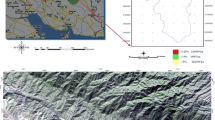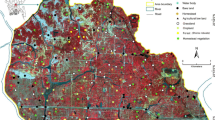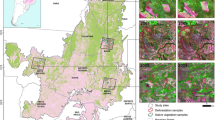Abstract
Remote sensing can provide large-scale spatial data for the detection of vegetation types. In this study, two shortwave infrared spectral bands (TM5 and TM7) and one visible spectral band (TM3) of Landsat 5 TM data were used to detect five typical vegetation types (communities dominated by Bothriochloa ischaemum, Artemisia gmelinii, Hippophae rhamnoides, Robinia pseudoacacia, and Quercus liaotungensis) using 270 field survey data in the Yanhe watershed on the Loess Plateau. The relationships between 200 field data points and their corresponding radiance reflectance were analyzed, and the equation termed the vegetation type index (VTI) was generated. The VTI values of five vegetation types were calculated, and the accuracy was tested using the remaining 70 field data points. The applicability of VTI was also tested by the distribution of vegetation type of two small watersheds in the Yanhe watershed and field sample data collected from other regions (Ziwuling Region, Huangling County, and Luochuan County) on the Loess Plateau. The results showed that the VTI can effectively detect the five vegetation types with an average accuracy exceeding 80 % and a representativeness above 85 %. As a new approach for monitoring vegetation types using remote sensing at a larger regional scale, VTI can play an important role in the assessment of vegetation restoration and in the investigation of the spatial distribution and community diversity of vegetation on the Loess Plateau.










Similar content being viewed by others
References
Adler-Golden, S.M., Matthew, M.W., Bernstein, L.S., Levine, R.Y., Berk, A., Richtsmeier, S.C., Acharya, P.K., Anderson, G.P., Felde, J.W., & Gardner, J. (1999). Atmospheric correction for shortwave spectral imagery based on MODTRAN4. In, SPIE’s International Symposium on Optical Science, Engineering, and Instrumentation (pp. 61–69): International Society for Optics and Photonics.
An, H., & ShangGuan, Z.-P. (2007). Photosynthetic characteristics of dominant plant species at different succession stages of vegetation on Loess Plateau. Chinese Journal of Applied Ecology, 18, 1175–1180 (in Chinese with English abstract).
Carter, G. A., Lucas, K. L., Blossom, G. A., Lassitter, C. L., Holiday, D. M., Mooneyhan, D. S., Fastring, D. R., Holcombe, T. R., & Griffith, J. A. (2009). Remote sensing and mapping of tamarisk along the Colorado River, USA: a comparative use of summer-acquired Hyperion, Thematic Mapper and QuickBird data. Remote Sensing, 1, 318–329.
Chander, G., Markham, B. L., & Helder, D. L. (2009). Summary of current radiometric calibration coefficients for Landsat MSS, TM, ETM+, and EO-1 ALI sensors. Remote Sensing of Environment, 113, 893–903.
Chen, Y.-N., Ma, L.-S., Zhang, X.-R., Yang, J.-J., & An, S.-S. (2014). Ecological stoichiometry characteristics of leaf litter of Robinia pseudoacacia in the Loess Plateau of Shaanxi Province. Acta Ecologica Sinica, 34, 4412–4422 (in Chinese with English abstract).
Chopping, M. J., Rango, A., Havstad, K. M., Schiebe, F. R., Ritchie, J. C., Schmugge, T. J., French, A. N., Su, L., McKee, L., & Davis, M. R. (2003). Canopy attributes of desert grassland and transition communities derived from multiangular airborne imagery. Remote Sensing of Environment, 85, 339–354.
Congalton, R. G. (1991). A review of assessing the accuracy of classifications of remotely sensed data. Remote Sensing of Environment, 37, 35–46.
Dean, A. M., & Smith, G. M. (2003). An evaluation of per-parcel land cover mapping using maximum likelihood class probabilities. International Journal of Remote Sensing, 24, 2905–2920.
Duncan, J., Stow, D., Franklin, J., & Hope, A. (1993). Assessing the relationship between spectral vegetation indices and shrub cover in the Jornada Basin, New Mexico. International Journal of Remote Sensing, 14, 3395–3416.
Elmore, A. J., Mustard, J. F., Manning, S. J., & Lobell, D. B. (2000). Quantifying vegetation change in semiarid environments: precision and accuracy of spectral mixture analysis and the normalized difference vegetation index. Remote Sensing of Environment, 73, 87–102.
Erener, A. (2013). Classification method, spectral diversity, band combination and accuracy assessment evaluation for urban feature detection. International Journal of Applied Earth Observation and Geoinformation, 21, 397–408.
Erener, A., & Düzgün, H. S. (2009). A methodology for land use change detection of high resolution pan images based on texture analysis. Italian Journal of Remote Sensing, 41, 47–59.
Guang, Z., & Maclean, A. L. (2000). A comparison of canonical discriminant analysis and principal component analysis for spectral transformation. Photogrammetric Engineering & Remote Sensing, 66, 841–847.
Holben, B. (1986). Characteristics of maximum-value composite images from temporal AVHRR data. International Journal of Remote Sensing, 7, 1417–1434.
Hölzel, N., Buisson, E., & Dutoit, T. (2012). Species introduction—a major topic in vegetation restoration. Applied Vegetation Science, 15, 161–165.
Huang, X., Zhang, L., & Li, P. (2007). Classification and extraction of spatial features in urban areas using high-resolution multispectral imagery. Geoscience and Remote Sensing Letters, IEEE, 4, 260–264.
Huete, A. R. (1988). A soil-adjusted vegetation index (SAVI). Remote Sensing of Environment, 25, 295–309.
Jackson, R. D. (1984). Remote sensing of vegetation characteristics for farm management. Remote Sensing: Critical Review of Technology, 475, 81–96.
Jackson, R. D., & Huete, A. R. (1991). Interpreting vegetation indices. Preventive Veterinary Medicine, 11, 185–200.
Jensen, J. R. (2006). Remote sensing of the environment: an earth resource perspective. USA: Pearson Prentice Hall.
Jia, Y., Jiao, J., Wang, N., Zhang, Z., Bai, W., & Wen, Z. (2011). Soil thresholds for classification of vegetation types in abandoned cropland on the Loess Plateau, China. Arid Land Research and Management, 25, 150–163.
Jiao, J., Tzanopoulos, J., Xofis, P., & Mitchley, J. (2008a). Factors affecting distribution of vegetation types on abandoned cropland in the hilly-gullied Loess Plateau Region of China. Pedosphere, 18, 24–33.
Jiao, J., Zhang, Z., Jia, Y., Wang, N., & Bai, W. (2008b). Species composition and classification of natural vegetation in the abandoned lands of the hilly-gullied region of North Shaanxi Province. Acta Ecologica Sinica, 28, 2981–2997.
Jiao, F., Wen, Z.-M., & An, S.-S. (2011). Changes in soil properties across a chronosequence of vegetation restoration on the Loess Plateau of China. Catena, 86, 110–116.
Jin, T.-T., Liu, G.-H., Hu, C.-J., Su, C.-H., & Liu, Y. (2008). Characteristics of photosynthetic and transpiration of three common afforestation species in the Loess Plateau. Acta Ecologica Sinica, 28, 5758–5765.
Karnieli, A., Kaufman, Y. J., Remer, L., & Wald, A. (2001). AFRI—aerosol free vegetation index. Remote Sensing of Environment, 77, 10–21.
Kaufman, Y. J., & Tanre, D. (1992). Atmospherically resistant vegetation index (ARVI) for EOS-MODIS. IEEE Transactions on Geoscience and Remote Sensing, 30, 261–270.
Kaufman, Y. J., Wald, A. E., Remer, L. A., Gao, B. C., Li, R. R., & Flynn, L. (1997). The MODIS 2.1-μm channel-correlation with visible reflectance for use in remote sensing of aerosol. IEEE Transactions on Geoscience and Remote Sensing, 35, 1286–1298.
Li, D., Jiang, J., Liang, Y., Liu, G., & Huang, J. (1996). Study on water use efficiency of the artificial grassland at Ansai County in the Loess Hilly Region. Research of Soil and Water Conservation, 3, 66–74.
Major, D., Baret, F., & Guyot, G. (1990). A ratio vegetation index adjusted for soil brightness. International Journal of Remote Sensing, 11, 727–740.
Manandhar, R., Odeh, I., & Ancev, T. (2009). Improving the accuracy of land use and land cover classification of Landsat data using post-classification enhancement. Remote Sensing, 1, 330–344.
Nagase, A., & Dunnett, N. (2012). Amount of water runoff from different vegetation types on extensive green roofs: effects of plant species, diversity and plant structure. Landscape and Urban Planning, 104, 356–363.
Qi, J., Chehbouni, A., Huete, A., Kerr, Y., & Sorooshian, S. (1994). A modified soil adjusted vegetation index. Remote Sensing of Environment, 48, 119–126.
Qi, J., Marsett, R., & Heilman, P. (2000). Rangeland vegetation cover estimation from remotely sensed data. In, Proceedings of the 2nd International Conference on Geospatial Information in Agriculture and Forestry (pp. 243–252).
Qiu, L., Zhang, X., Cheng, J., & Yin, X. (2010). Effects of black locust (Robinia pseudoacacia) on soil properties in the loessial gully region of the Loess Plateau, China. Plant and Soil, 332, 207–217.
Sabins, F. F. (1987). Remote sensing principles and interpretation (2nd edn.). New York: Freeman.
Sakamoto, T., Wardlow, B. D., Gitelson, A. A., Verma, S. B., Suyker, A. E., & Arkebauer, T. J. (2010). A two-step filtering approach for detecting maize and soybean phenology with time-series MODIS data. Remote Sensing of Environment, 114, 2146–2159.
Shimada, S., Takahashi, H., & Limin, S. H. (2006). Hydroperiod and phenology prediction in a Central Kalimantan peat swamp forest by using MODIS data. Tropics, 15, 435–440.
Shimada, S., Matsumoto, J., Sekiyama, A., Aosier, B., & Yokohana, M. (2012). A new spectral index to detect Poaceae grass abundance in Mongolian grasslands. Advances in Space Research, 50, 1266–1273.
Shlien, S., & Smith, A. (1976). A rapid method to generate spectral theme classification of Landsat imagery. Remote Sensing of Environment, 4, 67–77.
Solutions, I.V.I. (2009). Atmospheric correction module: QUAC and FLAASH user’s guide. In, Boulder, CO: ITT Visual Information Solutions (p. 44).
Su, C. H., Fu, B. J., Wei, Y. P., Lu, Y. H., Liu, G. H., Wang, D. L., Mao, K. B., & Feng, X. M. (2012). Ecosystem management based on ecosystem services and human activities: a case study in the Yanhe watershed. Sustainability Science, 7, 17–32.
Sun, J., Yang, J., Zhang, C., Yun, W., & Qu, J. (2013). Automatic remotely sensed image classification in a grid environment based on the maximum likelihood method. Mathematical and Computer Modelling, 58, 573–581.
Thomlinson, J. R., Bolstad, P. V., & Cohen, W. B. (1999). Coordinating methodologies for scaling landcover classifications from site-specific to global: steps toward validating global map products. Remote Sensing of Environment, 70, 16–28.
Thorne, K., Markharn, B., Barker, P. S., & Biggar, S. (1997). Radiometric calibration of Landsat. Photogrammetric Engineering & Remote Sensing, 63, 853–858.
Tucker, C. J. (1980). A critical review of remote sensing and other methods for non-destructive estimation of standing crop biomass. Grass and Forage Science, 35, 177–182.
van den Elsen, E., Hessel, R., Liu, B. Y., Trouwborst, K. O., Stolte, J., Ritsema, C. J., & Blijenberg, H. (2003). Discharge and sediment measurements at the outlet of a watershed on the Loess plateau of China. Catena, 54, 147–160.
Wang, L., Wei, S., Horton, R., & Shao, M. A. (2011). Effects of vegetation and slope aspect on water budget in the hill and gully region of the Loess Plateau of China. Catena, 87, 90–100.
Wen, Z., Lees, B. G., Jiao, F., Lei, W., & Shi, H. (2010). Stratified vegetation cover index: a new way to assess vegetation impact on soil erosion. Catena, 83, 87–93.
Xie, Y., Sha, Z., & Yu, M. (2008). Remote sensing imagery in vegetation mapping: a review. Journal of Plant Ecology, 1, 9–23.
Yang, C., Everitt, J. H., & Murden, D. (2011). Evaluating high resolution SPOT 5 satellite imagery for crop identification. Computers and Electronics in Agriculture, 75, 347–354.
Acknowledgments
We would like to thank the National Nature Science Foundation of China (NSFC) projects (41371280; 41030532). We would also like to acknowledge the assistance of the Ansai Ecological Experimental Station for Soil and Water Conservation, CAS.
Author information
Authors and Affiliations
Corresponding author
Rights and permissions
About this article
Cite this article
Wang, ZJ., Jiao, JY., Lei, B. et al. An approach for detecting five typical vegetation types on the Chinese Loess Plateau using Landsat TM data. Environ Monit Assess 187, 577 (2015). https://doi.org/10.1007/s10661-015-4799-5
Received:
Accepted:
Published:
DOI: https://doi.org/10.1007/s10661-015-4799-5




